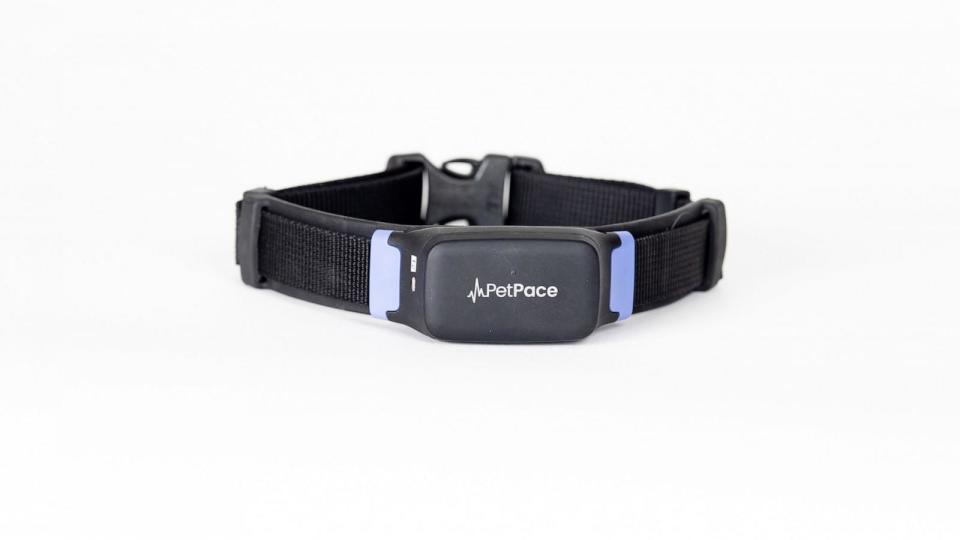A device that dogs wear on their collars could finally make use of thousands of years of anecdotes about a change in animal behavior on the brink of an earthquake.
The makers of the PetPace biometric collar, originally designed to track dog health data for early warning signs of disease, believe the physiological data it records has the ability to improve near-term earthquake predictions.
Measurements for the dog wearer’s heart rate, heart rate variability, temperature, respiration and activity are recorded and sent to the PetPace cloud in real time, Asaf Dagan, chief scientist and co-founder of PetPace, the parent company of Animal Alerts, told ABC News. An AI algorithm then determines the dog’s overall stress level.
“The idea is that if we can track the behavior and anxiety levels of animals… and then we use advanced AI and machine learning models to correlate that with geophysical data like earthquakes of different magnitudes,” Dagan said.
MORE: What scientists discovered after simulating an earthquake on a 10-story wooden building
The company sought pet owners spread across a geographic area to volunteer to have their dogs wear the smart collar. If all the dogs respond within the same time frame, the algorithm can likely identify a pattern that an earthquake may be coming, Dagan said. Dogs in a region with little seismic activity will also be monitored as a control group.
The project, titled Animal Alerts, is currently underway in Lima, Peru, where 90% of all seismic activity worldwide occurs due to its location along the Pacific Ring of Fire.

According to the US Geological Survey, the earliest reference ever to unusual animal behavior prior to a major earthquake occurred in 373 BC in Greece.
Several species — such as rats, weasels, snakes and centipedes — reportedly left their homes and headed for safety just days before a devastating earthquake struck the region, the USGS said.
MORE: Extreme waves in Marshall Islands highlight dangers of climate change, experts say
Other historical anecdotal evidence indicates that fish, birds, reptiles and insects exhibit strange behavior anywhere from weeks to seconds before an earthquake, according to the USGS. According to the American Kennel Club, cats, elephants and toads have also been observed to exhibit behavioral changes following an upcoming seismic event.
The evidence in recent decades has been largely anecdotal, according to a 2018 paper published in the Bulletin of the Seismological Society of America, which examined 180 previous studies.
Public opinion widely views abnormal animal behavior as a potential harbinger of an earthquake, the paper said. According to the USGS, scientists are still looking for consistent and reliable behavior in animals leading up to a seismic event.


Researchers from Germany filmed red carpenter ants nesting along a fault line in the Neuwied Basin, a seismically active region in the Eifel, Germany, and studied the ants’ behavior hours before the earthquake, according to a 2013 study. The scientists found that the nocturnal The ants’ resting phase and diurnal activity were suppressed prior to seismic activity, and that their standard daily routine was not resumed until the next day.
In a 2020 study, researchers from the Max Planck Institute of Animal Behavior and the University of Konstanz in Germany wrote that they accurately measured an increase in activity in a group of farm animals prior to seismic activity.
The scientists measured the activity of several cows, dogs and sheep on a farm near the epicenter of the magnitude 6.6 earthquake that struck in October 2016 near the Norcia basin in central Italy and found that there were strong responses among the animals were before earthquakes of magnitude 3.8 or greater. when they were together in a stable, but not when they were in the meadow, the research shows. Before the earthquake, the animals were equipped with biologgers and GPS sensors, highly sensitive instruments that record accelerated movements in any direction – up to 48 per second.
MORE: How regional fault lines led to such a devastating earthquake in Turkey and Syria
According to the study, the farm animals seemed to anticipate vibrations anywhere from one to 20 hours in advance. They responded earlier when they were closer to the origin and later when they were further away, but no clear link was made between the behavioral changes.
Earthquake geologist Wendy Bohon was skeptical about the idea that a smart collar for dogs could help predict earthquakes, despite how “interesting” a concept it may be, she told ABC News.
“I’ve never seen a convincing study showing that animals can predict earthquakes, or that animals know an earthquake is going to happen before it happens,” Bohon said.


Earthquakes are difficult to predict because there is currently no evidence that there are precursors to seismic activity, Bohon said.
“We just didn’t find anything,” she said.
Dogs are ideally suited for observation of behavioral responses because of their acute senses of smell and sound that detect stimuli that humans cannot, Dagan said.
“Dogs are particularly useful models of this phenomenon because of their keen senses and their proximity to humans,” Rachell Grant, a behavioral ecologist at London South Bank University and leader of the Animal Alert project, said in a statement.
MORE: Cat rescued from rubble 15 days after Italy earthquake
Dogs can smell odors and hear high-pitched sounds that are imperceptible to humans, allowing them to perceive things beyond human perception, according to the American Kennel Club. A 2012 paper examining whether dogs can have seasonal affective disorder found that 49% of dogs showed a significant increase in anxiety the day before a magnitude 6.8 earthquake struck the Pacific Northwest in February 2001. In addition, 47% of dogs were significantly more active – a sharp increase from the stable daily averages collected until then, the study found.
The puppies are probably sensing and reacting to something unusual. The dogs may pick up tremors, the smaller earthquakes that occur before a larger one, or acoustic waves generated by the movement of the tectonic plates, the organization said.
“Sometimes animals sense the arrival of waves from far away, which are too small to feel,” Bohon said. “…And so we don’t notice the first small waves arriving, so it may seem like the animals are predicting the earthquake, when in reality they are reacting to the first wave arrivals that we’re just not attuned to.”


These primary or ‘P’ waves are the first emitted by the earthquake and travel at a speed of several kilometers per second from the epicenter, which could make them more visible to animals, according to the USGS.
Very few people notice the smaller “P” waves, which arrive before the larger “S” waves, according to the USGS.
The dogs can also sense the ionization of air on pressurized rock surfaces, as well as changes in the electric field or the odor of chemicals released.
But there is no conclusive evidence showing that dogs can predict vibrations, the organization said.
MORE: Dog rescued after being trapped under rubble left by Italy earthquake for nine days
The idea that observational data can be used to predict an upcoming earthquake has been touted in the past. Researchers proposed in 2018 that crowdsourcing and social media could help predict earthquakes and developed a prototype that would allow social media users to upload posts about abnormal animal behavior.
Social media users claimed animals were behaving strangely in the hours before a magnitude 7.8 earthquake struck Turkey in February 2023, killing more than 21,000 people. The reported behavior included birds flying erratically and dogs howling loudly, The Washington Post reported.
There is currently no existing technology that can reliably predict earthquakes.
In 2015, researchers noticed changes in animal behavior three weeks before a magnitude 7.0 earthquake in the Amazon region of Peru in 2011. They used a series of cameras that suggested animals could be an affordable earthquake warning system. This is evident from a study published in the journal Physics and Chemistry of Peru. found the earth.
Scientists want as much data as they can get, and this approach could increase the sample size of animal behavior before an earthquake that has already been studied, Bohon said.
“We want all the data and information we can get so we can investigate every possibility,” she said. “But extraordinary claims require extraordinary evidence.”
A wearable device could help dogs predict earthquakes, its makers say originally on abcnews.go.com